
Indicator scoreboard
EMU - September M3 money supply growth rose to 7.4 percent, up from 7.0 percent in August. The 3-month moving average of year over year rates, the key indicator for the ECB, was unchanged at 7.1 percent for the July-to-September period. The latest reading remains well above the ECB's 4.5 percent M3 growth reference rate.

August current account surplus rose to €9.7 billion, up strongly from a €5.3 billion deficit in August 2001. The improvement in the current account was caused mainly by an increase in the merchandise goods surplus to €11.7 billion from €7.4 billion a year earlier. The services surplus showed a small increase to €1.3 billion from €1.0 billion while income and current transfers remained broadly unchanged.
August real workday and seasonally adjusted retail sales rose 0.8 percent and 1.5 percent when compared with last year. All categories rose except for non-food products, textiles, household goods, books and newspapers sales and non-specialized stores.

October flash harmonized index of consumer prices rose by 2.2 percent on the year. To compute its HICP flash estimates, Eurostat uses early price information provided by Germany, Italy and - if available - by other member states, as well as early information about energy prices.

October Reuters purchasing managers index showed the manufacturing sector contracted for the second month in row but at a slightly slower pace, thanks to a recovery in output. The PMI index rose to 49.1, barely above the 48.9 reading in September. An index level reading below the 50 level signals contraction, while a reading above 50, expansion.

EU - October EU Commission's economic sentiment index slipped to 98.9 from September's level of 99.0. Industrial sentiment rose to minus 10 from last month's minus 12. However, consumer sentiment fell to minus 12 from minus 9 last month. The overall indicator fell in the Netherlands, Portugal, Italy, Belgium, Germany and Finland. The increase in industrial confidence was due to increased production expectations and orders as well as a fall in inventories. Most subcomponents of consumer confidence fell, led by expectations of the general economic situation and consumers' expectations regarding their financial situation and savings over the next 12 months. Construction confidence remained stable while retail trade confidence rose. The services confidence indicator fell four points, mainly due to the worsening assessment of the business climate.

Germany - October Ifo Institute's west German business sentiment index posted its fifth consecutive monthly drop due entirely to weaker confidence in the manufacturing sector. The index fell to 87.7 from 88.2 in September. The September drop was due to continued stock market turmoil, worries about a possible U.S.-led war against Iraq, other signs of weak German growth and concerns about the effects of the German government's tax-heavy deficit reduction plans. The fall in the overall index was due to a drop in the west German future expectations sub-index, which fell to 97.9 from 99.3. However, the west German current business conditions sub-index rose slightly. East German business sentiment declined to 97.9 from 98.5.
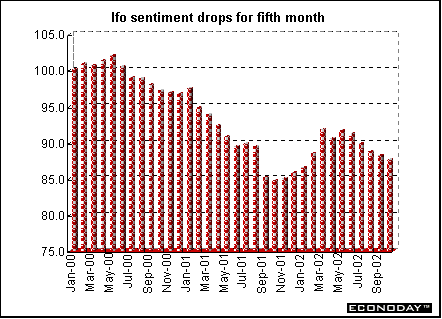
August seasonally adjusted industrial production in August was revised down to an increase of 1.3 percent from the increase of 1.8 percent originally reported. German industrial production excluding construction - the figure that Eurostat uses to calculate eurozone industrial output - was revised down to an increase of 1.5 percent from an initial climb of 2.1 percent.
France - September producer prices rose 0.4 percent boosted by a 2.3 percent increase in energy prices. When compared with last year, producer prices were up 0.3 percent. Core PPI, excluding energy and agriculture, remained unchanged on the month and rose 0.4 percent on the year.
September seasonally adjusted unemployment edged up by 4,000. The unemployment rate remained steady at 9.0 percent for the fourth month in a row. The September increase boosted the number of jobless to 2.43 million, up 103,000 on the year, according to the International Labour Organization definition, which excludes jobseekers who did any work during the month.
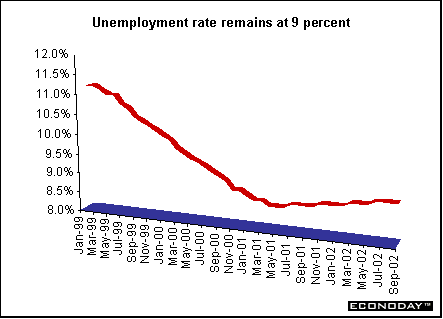
Italy - September producer prices rose 0.4 percent and 0.5 percent when compared with last year. The increase was due to higher oil and natural gas prices. The PPI excluding energy was unchanged on the month but up 1.0 percent on the year.
Britain - October Nationwide house price index rose 1.4 percent and 24.0 percent on the year. October's increase was the lowest monthly change since March.
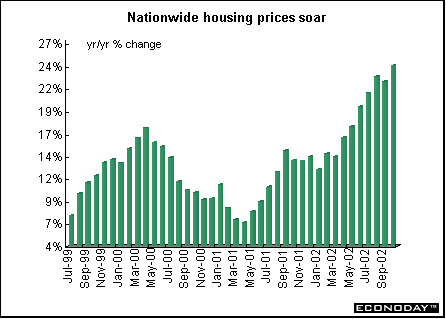
Asia
Japan - September seasonally adjusted retail sales fell 0.1 percent last month after a 2.7 percent gain in August. Sales fell 3 percent when compared with last year. Sales at supermarkets and department stores and other large retailers open at least a year rose 0.2 percent but fell 0.7 percent from a year earlier.
September unemployment rate was unchanged at 5.4 percent - just below the record 5.5 percent of last December. But the number of unemployed climbed for an 18th straight month, increasing by 80,000 from the same month a year ago to 3.65 million. Construction companies, which employ one in 10 people, shed 120,000 jobs in September. Job conditions were worst among contractors and manufacturers; contractors have cut their number of workers for 22 straight months and manufacturers 17 straight months. But service-related companies added new jobs for the 31st straight month. There were 55 jobs per applicant, one more than in August.
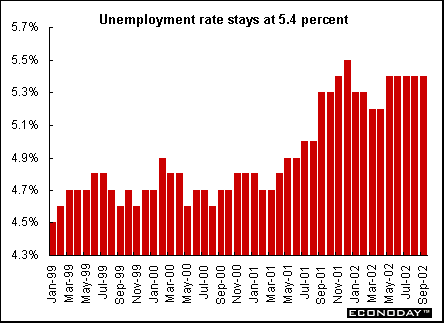
September real spending by households headed by a salaried worker rose by 5.6 percent and 4.1 percent when compared with last year. Wage earner spending accounts for roughly 55 percent of gross domestic product. By category, communications-related spending jumped 32.5 percent on year due to higher spending on mobile phones, while spending in transportation showed a 13.4 percent rise. Travel-related spending also grew strongly. Seasonally adjusted propensity for wage earners to consume, a ratio that measures the amount of disposable income that went to household spending, rose to 75.0 percent from 71.4 percent in August.
Americas
Canada - September industrial product price index (IPPI) jumped 0.7 percent and 0.5 percent when compared with last year. On the year, there were price increases for primary metals, fruit, vegetable and feed products, motor vehicles and other transport equipment, and chemicals and chemical products. However, there were also lower prices for lumber products, petroleum and coal products, and pulp and paper products, which dampened the increase.
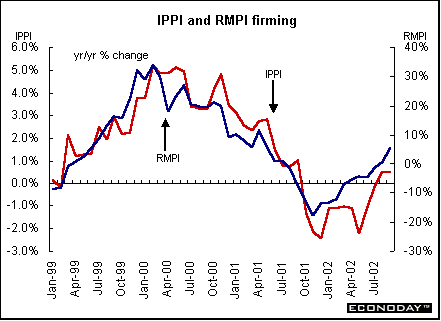
September raw materials price index (RMPI) jumped 2.1 percent and 5.6 percent when compared with last year. Higher prices for mineral fuels and vegetable products as well as for wood products and non-ferrous metals were responsible for the annual rise. These increases were partly offset by lower prices for animal products. Excluding mineral fuels, the RMPI increased 3.3 percent. Crude oil prices were up 5.0 percent, mainly the result of lower inventories and the decision of the Organization of Petroleum Exporting Countries (OPEC) to maintain production quotas.
In September, the value of the U.S. dollar strengthened against the Canadian dollar, pushing up prices of commodities that are quoted in U.S. dollars. As a result, the total IPPI excluding the effect of the exchange rate would have increased 0.2 percent instead of 0.7 percent. The influence of the dollar also had an impact when compared with a year ago. The IPPI was up 0.5 percent from September 2001 to September 2002, but without the exchange rate effect the IPPI would have increased a mere 0.1 percent.
August gross domestic product at factor cost edged up 0.1 percent after a strong 0.5 percent gain in July. It was the eleventh consecutive monthly increase. Consumers continued to purchase new and existing housing in record numbers, leading to higher output for residential construction. Industrial production (mining, utilities and manufacturing) fell 0.4 percent after a sharp 1.6 percent increase in July. Mining fell 1.6 percent on weakness in oil and gas production and exploration. Utilities were down 1.6 percent as well, on a 1.7 percent drop in electricity generation. The slight manufacturing gain was due to gains by durable goods producers including manufacturers of transportation equipment, fabricated metal products and furniture.



Last Week's Highlights • Global
Stock Market Indexes • Recap of Global Markets
• Currencies • Indicator
Scoreboard

The Bottom Line •
Looking Ahead
|